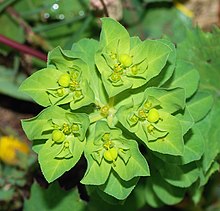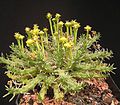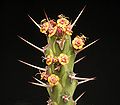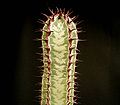| Revision as of 22:22, 22 December 2015 editMaterialscientist (talk | contribs)Edit filter managers, Autopatrolled, Checkusers, Administrators1,994,307 edits Reverted 1 good faith edit by OmegaBuddy13 using STiki← Previous edit | Revision as of 00:45, 23 December 2015 edit undoOmegaBuddy13 (talk | contribs)137 edits Undid revision 696401752 by Materialscientist (talk)Next edit → | ||
| Line 146: | Line 146: | ||
| * '']'' – myrtle spurge, creeping spurge, donkey tail | * '']'' – myrtle spurge, creeping spurge, donkey tail | ||
| * '']'' – Indian spurge tree | * '']'' – Indian spurge tree | ||
| * '']'' | * '']'' - Living baseballs | ||
| * '']'' | * '']'' | ||
| * '']'' – sea spurge | * '']'' – sea spurge | ||
Revision as of 00:45, 23 December 2015
Not to be confused with euphoria.- For the family commonly called "euphorbias", see Euphorbiaceae
| Euphorbia | |
|---|---|

| |
| Euphorbia cf. serrata' | |
| Scientific classification | |
| Kingdom: | Plantae |
| (unranked): | Angiosperms |
| (unranked): | Eudicots |
| (unranked): | Rosids |
| Order: | Malpighiales |
| Family: | Euphorbiaceae |
| Subfamily: | Euphorbioideae |
| Tribe: | Euphorbieae |
| Subtribe: | Euphorbiinae Griseb. |
| Genus: | Euphorbia L. |
| Type species | |
| Euphorbia antiquorum L. | |
| Subgenera | |
|
Chamaesyce | |
| Diversity | |
| c. 2008 species | |
| Synonyms | |
|
Chamaesyce | |
Euphorbia (spurge) is a very large and diverse genus of flowering plants in the spurge family (Euphorbiaceae). Sometimes in ordinary English, "euphorbia" is used to refer to the entire Euphorbiaceae family (as the type genus), not just to members of the genus. Some euphorbias are well known and widely commercially available, such as Poinsettias at Christmas. Some are commonly cultivated as ornamentals, or collected and highly valued for the aesthetic appearance of their unique floral structures, such as the Crown of Thorns plant. Euphorbias from the deserts of Southern Africa and Madagascar have evolved physical characteristics and forms similar to cacti of North and South America, so they (along with various other kinds of plants) are often incorrectly referred to as "cacti", although they are far from being related as plants, see below. Some are used as ornamentals in landscaping, because of beautiful or striking overall forms, and drought and heat tolerance. Botanists may be fascinated by the diversity or bizarreness of some of the floral structures, and by the range of growth forms and adaptations to such a wide range of habitats.
Euphorbias range from tiny annual plants to large and long-lived trees. The genus has over or about 2,000 members, making it one of the largest genera of flowering plants. It also has one of the largest ranges of chromosome counts, along with Rumex and Senecio. Euphorbia antiquorum is the type species for the genus Euphorbia. It was first described by Carl Linnaeus in 1753 in Species Plantarum.
The plants share the feature of having a poisonous, milky, white latex-like sap, and unusual and unique kind of floral structures. The genus may be described by properties of its members' gene sequences, or by the shape and form (morphology) of its heads of flowers. When viewed as a whole, the head of flowers looks like a single flower (a pseudanthium). It has a unique kind of pseudanthium, called a cyathium, where each flower in the head is reduced to its barest essential part needed for sexual reproduction. The individual flowers are either male or female, with the male flowers reduced to only the stamen, and the females to the pistil. These flowers have no sepals, petals, or other parts that are typical of flowers in other kinds of plants. Structures supporting the flower head and beneath that have evolved to attract pollinators with nectar, and with shapes and colors that function the way petals and other flower parts do in other flowers. It is the only genus of plants that has all three kinds of photosynthesis, CAM, C3, and C4.
The genus can be found all over the world. The forms range from annual plants laying on the ground, to well developed tall trees. In deserts in Madagascar and southern Africa, convergent evolution has led to cactus-like forms where the plants occupy the same ecological niche as cacti do in deserts of North America and South America. The genus is primarily found in the tropical and subtropical regions of Africa and the Americas, but also in temperate zones worldwide. Succulent species originate mostly from Africa, the Americas and Madagascar. There exists a wide range of insular species.
Misidentification as cacti

Among laypersons, Euphorbias are among the most commonly confused plant taxa with cacti, especially the stem succulents. Euphorbias secrete a sticky, milky-white fluid with latex, but cacti do not. Individual flowers of Euphorbias are usually tiny and nondescript (although structures around the individual flowers may not be), without petals and sepals, unlike cacti, which often have fantastically showy flowers. Euphorbias from desert habitats with growth forms similar to cacti have thorns, which are different from the spines of cacti.
Etymology
The common name "spurge" derives from the Middle English/Old French espurge ("to purge"), due to the use of the plant's sap as a purgative. The botanical name Euphorbia derives from Euphorbos, the Greek physician of king Iuba (or Juba) II of Numidia (52–50 BC – 23 AD), who married the daughter of Anthony and Cleopatra. Juba was a prolific writer on various subjects, including natural history. Euphorbos wrote that one of the cactus-like Euphorbias (now called Euphorbia obtusifolia ssp. regis-jubae) which was used as a powerful laxative. In 12 B.C., Juba named this plant after his physician Euphorbos, as Augustus Caesar had dedicated a statue to the brother of Euphorbos, Antonius Musa, who was the personal physician of Augustus. In 1753, Botanist and taxonomist Carl Linnaeus assigned the name Euphorbia to the entire genus in the physician's honor.
Description
The plants are annual or perennial herbs, woody shrubs or trees with a caustic, poisonous milky latex. The roots are fine or thick and fleshy or tuberous. Many species are more or less succulent, thorny or unarmed. The main stem and mostly also the side arms of the succulent species are thick and fleshy, 15–91 cm (6–36 inches) tall. The deciduous leaves may be opposite, alternate, or in whorls. In succulent species the leaves are mostly small and short-lived. The stipules are mostly small, partly transformed into spines or glands, or missing.
Inflorescence and fruit

Like all members of the family Euphorbiaceae, all spurges have unisexual flowers.
In Euphorbia, flowers occur in a head, called the cyathium (plural cyathia). Each male or female flower in the cyathium head has only its essential sexual part, in males the stamen, and in females the pistil. The flowers do not have sepals, petals, or nectar to attract pollen, although other non-flower parts of the plant have an appearance and nectar glands with similar roles. Euphorbias are the only plants known to have this kind of flower head.
Nectar glands and nectar that attract pollinators are held in the involucre, a cuplike part below and supporting the cyathium head. (The "involucre" in the Euphorbia genus is not to be confused with the "involucre" in Asteraceae family members, which is a collection of bracts called (phyllaries), which surround and encase the unopened flower head, then support the receptacle under it after the flower head opens.)
The involucre is above and supported by bract-like modified leaf structures (usually in pairs) called cyathophylls, or cyathial leaves. The cyathophyll often has a superficial appearance of being petals of a flower.
Euphorbia flowers are tiny, and the variation attracting different pollinators (and the human eye), with different forms and colors occurs, in the cyathium, involucre, cyathophyll, or additional parts such as glands that attached to these.
The collection of many flowers may be shaped and arranged to appear collectively as a single individual flower, sometimes called a pseudanthium in Asteraceae, and also in Euphorbia.
The majority of species are monoecious (bearing male and female flowers on the same plant), although some are dioecious with male and female flowers occurring on different plants. It is not unusual for the central cyathia of a cyme to be purely male, and for lateral cyathia to carry both sexes. Sometimes young plants or those growing under unfavorable conditions are male only, and only produce female flowers in the cyathia with maturity or as growing conditions improve.
The female flowers reduced to a single pistil usually spit into 3 parts, often with 2 stigmas at each tip.
male flowers often have anthers in 2's.
Nectar glands usually occur in 5's, may be as few as one, and may be fused into a "U"-shape.
The cyathophylls often occur in 2's, are leaf-like, and may be showy and brightly coloured and attractive to pollinators, or be reduced to barely visible tiny scales.
The fruits are three (rarely two) compartment capsules, sometimes fleshy but almost always ripening to a woody container that then splits open (explosively, see explosive dehiscence). The seeds are 4-angled, oval or spherical, and in some species have a caruncle.
Xerophytes and succulents
In the genus Euphorbia, succulence in the species has often evolved divergently and to differing degrees. Sometimes it is difficult to decide, and it is a question of interpretation, whether or not a species is really succulent or "only" xerophytic. In some cases, especially with geophytes, plants closely related to the succulents are normal herbs. About 850 species are succulent in the strictest sense. If one includes slightly succulent and xerophytic species, this figure rises to about 1000, representing about 45% of all Euphorbia species.
Irritants
The milky sap of spurges (called "latex") evolved as a deterrent to herbivores. It is white and colorless when dry, except in E. abdelkuri, where it is yellow. The pressurized sap seeps from the slightest wound and congeals after a few minutes in air. The skin irritating and caustic effects are largely caused by varying amounts of diterpenes. Triterpenes such as betulin and corresponding esters are other major components of the latex. In contact with mucous membranes (eyes, nose, mouth), the latex can produce extremely painful inflammation. Therefore, spurges should be handled with caution and kept away from children and pets. Latex on skin should be washed off immediately and thoroughly. Congealed latex is insoluble in water, but can be removed with an emulsifier like milk or soap. A physician should be consulted if inflammation occurs, as severe eye damage including permanent blindness may result from exposure to the sap. When large succulent spurges in a greenhouse are cut, vapours can cause irritation to the eyes and throat several metres away. Precautions, including sufficient ventilation, are required.
Uses



Several spurges are grown as garden plants, among them Poinsettia (E. pulcherrima) and the succulent E. trigona. E. pekinensis (Chinese: 大戟; pinyin: dàjǐ) is used in traditional Chinese medicine, where it is regarded as one of the 50 fundamental herbs. Several Euphorbia species are used as food plants by the larvae of some Lepidoptera (butterflies and moths), like the Spurge Hawk-moths (Hyles euphorbiae and Hyles tithymali), as well as the Giant Leopard Moth.
Ingenol mebutate, a drug used to treat actinic keratosis, is a diterpenoid which is found in Euphorbia peplus.
Euphorbia is often used as a hedging plant in many parts of Africa.
Systematics and taxonomy
Euphorbia corresponds to what was its own former subtribe, Euphorbiinae. It has over 2000 species. Morphological description using the presence of a cyathium (see section above) is consistent with nuclear and chloroplast DNA sequence data in testing of about 10% of its members. This testing supports inclusion of formerly other genera as being best placed in this single genus, including Chamaesyce, Monadenium, Pedilanthus, and Poinsettia (E. pulcherrima).
But genetic tests have shown that similar flower head structures or forms within the genus, might not mean close ancestry within the genus. The genetic data shows that within the genus, there may be convergent evolution of inflorescence structures from ancestral subunits that are not related. So using morphology within the genus becomes problematic for further subgeneric grouping. As stated on the Euphorbia Planetary Biodiversity Inventory project webpage -
"Previous morphologically based delimitations of subgenera or sections within the genus should not be taken at face value. The genus is in fact rife with striking examples of morphological convergence in cyathial and vegetative features, which justifies a global approach to studying the genus to obtain a proper phylogenetic understanding of the whole group.... The bottom line is that a number of clades have been placed inside or outside of Euphorbia at different times... few of the subgeneric circumscriptions hold up under DNA sequence analysis."
According to a 2002 publication on studies of DNA sequence data, most of the smaller "satellite genera" around the huge genus Euphorbia nest deep within the latter. Consequently these taxa, namely the never generally accepted genus Chamaesyce as well as the smaller genera Cubanthus, Elaeophorbia, Endadenium, Monadenium, Synadenium and Pedilanthus were transferred to Euphorbia. The entire subtribe Euphorbiinae now consists solely of the genus Euphorbia.
Selected species
See List of Euphorbia species for complete list.
- Euphorbia albomarginata – rattlesnake weed, white-margined sandmat
- Euphorbia amygdaloides – wood spurge
- Euphorbia antisyphilitica – candelilla
- Euphorbia balsamifera – sweet tabaiba (Canary Islands)
- Euphorbia bulbispina
- Euphorbia calyptrata
- Euphorbia canariensis – cardón (Canary Islands)
- Euphorbia caput-medusae - Medusa's head (South Africa)
- Euphorbia characias - Mediterranean spurge
- Euphorbia cotinifolia - Copper tree
- Euphorbia cyparissias – cypress spurge
- Euphorbia decidua
- Euphorbia dendroides - tree spurge
- Euphorbia echinus
- Euphorbia elastica – palo amarillo
- Euphorbia epithymoides – cushion spurge
- Euphorbia esula – leafy spurge
- Euphorbia falcata
- Euphorbia franckiana
- Euphorbia grantii – African milk bush
- Euphorbia granulata
- Euphorbia griffithii
- Euphorbia guyoniana
- Euphorbia helioscopia – sun spurge
- Euphorbia heterophylla – painted euphorbia, desert poinsettia, fireplant, paint leaf, kaliko
- Euphorbia hirta
- Euphorbia horrida - African milk barrel
- Euphorbia hypericifolia - "Inneuphe" diamond frost
- Euphorbia ingens - candelabra tree
- Euphorbia labatii
- Euphorbia lactea – mottled spurge, frilled fan, elkhorn
- Euphorbia lathyris – caper spurge, paper spurge, gopher spurge, gopher plant, mole plant
- Euphorbia leuconeura – Madagascar jewel
- Euphorbia maculata – spotted spurge, prostrate spurge
- Euphorbia marginata – snow on the mountain
- Euphorbia mammillaris
- Euphorbia maritae
- Euphorbia milii – crown-of-thorns, Christ plant
- Euphorbia myrsinites – myrtle spurge, creeping spurge, donkey tail
- Euphorbia neriifolia – Indian spurge tree
- Euphorbia obesa - Living baseballs
- Euphorbia obtusifolia
- Euphorbia paralias – sea spurge
- Euphorbia pekinensis - Peking spurge
- Euphorbia peplis – purple spurge
- Euphorbia peplus – petty spurge
- Euphorbia polychroma - bonfire
- Euphorbia psammogeton – sand spurge
- Euphorbia pulcherrima – poinsettia, Mexican flame leaf, Christmas star, winter rose, noche buena, lalupatae, pascua, Atatürk çiçeği (Turkish)
- Euphorbia purpurea
- Euphorbia resinifera – resin spurge
- Euphorbia rigida – gopher spurge, upright myrtle spurge
- Euphorbia serrata – serrated spurge, sawtooth spurge
- Euphorbia terracina – Geraldton carnation weed
- Euphorbia tirucalli – Indian tree spurge, milk bush, pencil tree, firestick
- Euphorbia tithymaloides – devil's backbone, redbird cactus, cimora misha (Peru)
- Euphorbia trigona – African milk tree, cathedral cactus, Abyssinian euphorbia
- Euphorbia virosa
- Euphorbia xanti - Baja spurge
Subgenera

The genus Euphorbia is one of the largest and most complex genera of flowering plants and several botanists have made unsuccessful attempts to subdivide the genus into numerous smaller genera. According to the recent phylogenetic studies, Euphorbia can be divided into 4 subgenera, each containing several not yet sufficiently studied sections and groups. Of these, Esula is the most basal. Chamaesyce and Euphorbia are probably sister taxa but very closely related to Rhizanthium. Extensive xeromorph adaptations in all probability evolved several times; it is not known if the common ancestor of the cactus-like Rhizanthium and Euphorbia lineages was xeromorphic—in which case a more normal morphology would have re-evolved namely in Chamaesyce—or whether extensive xeromorphism is entirely polyphyletic even to the level of the subgenera.
- Esula
-
 Wood Spurge
Wood Spurge
Euphorbia amygdaloides -
 Cypress Spurge
Cypress Spurge
Euphorbia cyparissias -
 Leafy Spurge
Leafy Spurge
Euphorbia esula -
Myrtle Spurge
Euphorbia myrsinites
- Rhizanthium
-
 Euphorbia ferox
Euphorbia ferox
-
 Euphorbia flanaganii
Euphorbia flanaganii
-
 Euphorbia meloformis ssp. valida
Euphorbia meloformis ssp. valida
-
 Euphorbia obesa ssp. symmetrica
Euphorbia obesa ssp. symmetrica
- Chamaesyce
-
 Euphorbia celastroides
Euphorbia celastroides
-
Painted Euphorbia
Euphorbia heterophylla -
 Poinsettia
Poinsettia
Euphorbia pulcherrima -
 Euphorbia rivae
Euphorbia rivae
- Euphorbia
-
 Euphorbia actinoclada
Euphorbia actinoclada
-
 Euphorbia attastoma var. attastoma
Euphorbia attastoma var. attastoma
-
 Euphorbia confinalis ssp. rhodesica
Euphorbia confinalis ssp. rhodesica
-
 Euphorbia lupulina
Euphorbia lupulina
-
 Euphorbia neriifolia
Euphorbia neriifolia
References
- Euphorbia, Merriam Webster Dictionary
- Cacti or Not? Many plants look like cacti but are not, CactiGuide.com
- ^ Project Page Introduction, Euphorbia Planetary Biodiversity Inventory project,
- ^ Plant Guide, Genus: Spurge - Euphorbia, Fine Gardening
- "WCSP". World Checklist of Selected Plant Families. Retrieved 2011-04-16.
- ^ Stebbins, G. L.; Hoogland, R. D. (1976). "Species diversity, ecology and evolution in a primitive Angiosperm genus:Hibbertia (Dilleniaceae)". Plant Systematics and Evolution. 125 (3): 139. doi:10.1007/BF00986147.
- Euphorbia Botany Lesson, Garden Web
- S. Carter (2002). "Euphorbia". In Urs Eggli (ed.). Dicotyledons. Illustrated Handbook of Succulent Plants. Vol. 5. Springer. p. 102. ISBN 978-3-540-41966-2.
- ^ What's the Difference Between Cacti and Succulents?, About.com
- ^ Nancy Dale (1986). Flowering Plants of the Santa Monica Mountains. California Native Plant Society. p. 107. ISBN 978-0-88496-239-7.
- Carl Linnaeus (1753). "Euphorbia". Species Plantarum (1st ed.). p. 450.
- ^ About the genus Euphorbia, Euphorbia Planetary Biodiversity Inventory project,
- ^ Euphorbia "Flowers," an introduction to the amazing Cyathia, Geoff Stein, 4-22-2011, Dave's Garden,
- Research into Euphorbia latex and irritant ingredients. Collected by Dr. Richard J. Hodgkiss. Retrieved November 2, 2013.
- Tom Eke, Sahar Al-Husainy & Mathew K. Raynor (2000). "The spectrum of ocular inflammation caused by Euphorbia plant sap" (PDF). Arch Ophthalmol. 118 (1): 13–16. doi:10.1001/archopht.118.1.13. PMID 10636407.
- Adamson, J. (2011). Born Free: The Full Story. Pan Macmillan. p. 23. ISBN 9780330536745. Retrieved 2014-10-06.
- ^ Victor W. Steinmann & J. Mark Porter (2002). "Phylogenetic relationships in Euphorbieae (Euphorbiaceae) based on ITS and ndhF sequence data". Annals of the Missouri Botanical Garden. 89 (4): 453–490. JSTOR 3298591.
- ^ Victor W. Steinmann (2003). "The submersion of Pedilanthus into Euphorbia (Euphorbiaceae)" (PDF). Acta Botanica Mexicana. 65: 45–50.
- ^ Peter V. Bruyns, Ruvimbo J. Mapaya & Terrence J. Hedderson (2006). "A new subgeneric classification for Euphorbia (Euphorbiaceae) in southern Africa based on ITS and psbA-trnH sequence data". Taxon. 55 (2): 397–420. doi:10.2307/25065587.
- Víctor W. Steinmann, Benjamin van Ee, Paul E. Berry & Jorge Gutiérrez (2007). "The systematic position of Cubanthus and other shrubby endemic species of Euphorbia (Euphorbiaceae) in Cuba". Anales del Jardín Botánico de Madrid. 64 (2): 123–133. doi:10.3989/ajbm.2007.v64.i2.167.
{{cite journal}}: CS1 maint: multiple names: authors list (link) - E. balsamifera. Flora de Canarias.
- E. canariensis. Flora de Canarias.
Further reading
- Buddensiek, Volker (2005): Succulent Euphorbia plus (CD-ROM). Volker Buddensiek Verlag.
- Carter, Susan (1982): New Succulent Spiny Euphorbias from East Africa
- Carter, Susan & Eggli, Urs (1997): The CITES Checklist of Succulent Euphorbia Taxa (Euphorbiaceae)
- Carter, Susan & Smith, A. L. (1988): Flora of Tropical East Africa, Euphorbiaceae
- Noltee, Frans (2001): Succulents in the wild and in cultivation, Part 2 Euphorbia to Juttadinteria (CD-ROM)
- Eggli, Urs (ed.) (2002): Sukkulentenlexikon (Vol. 2: Zweikeimblättrige Pflanzen (Dicotyledonen)). Eugen Ulmer Verlag.
- Everitt, J.H.; Lonard, R.L.; Little, C.R. (2007). Weeds in South Texas and Northern Mexico. Lubbock: Texas Tech University Press. ISBN 0-89672-614-2.
- Pritchard, Albert (2003): Introduction to the Euphorbiaceae ISBN 978-88-900511-4-2.
- Schwartz, Herman (ed.) (1983): The Euphorbia Journal Strawberry Press, Mill Valley, California, USA
- Singh, Meena (1994): Succulent Euphorbiaceae of India. Mrs. Meena Singh, A-162 Sector 40, NOIDA, New Delhi, India.
- Turner, Roger (1995): Euphorbias—A Gardeners' Guide. Batsford, England.
- Aditya Soumen (2010, April) A revision of geophytic euphorbia species from India. Euphorbia World journal. Vol.6-No.1, ISSN 1746-5397
- Pritchard albert "Monadenium" cactus & co. ISBN 978-88-95018-02-7
External links
- International Euphorbia Society
- Euphorbia
- Succulent Euphorbias
- A selection of important / new literature
- The Euphorbia Family
- ITIS
- IPNI
- Flora Zambesiaca: Euphorbia
- Template:Fr icon Institut de l’Information Scientifique et Technique